A Stagecoach Stop on the Great Road
With an Optional Cycling Trip Through
Little Bennett Regional Park
Hyattstown, stretching along a single tree-shaded thoroughfare, is a well-preserved example of the small roadside towns that sprang up along early highways built to link the westward-moving frontier to coastal ports. One of these arteries, opened about 1750 to connect the tobacco port of Georgetown with Frederick and beyond, was know locally as the “Great Road.” Once in part an old Indian trail, it has been widened and much improved over the years; now it is Maryland Route 355.
The Great Road has witnessed many notable people and events in American history. General Edward Braddock’s troops rode this path in April 1775 to Braddock’s disastrous defeat and death by the French and Indians near present-day Pittsburgh. George Washington traveled it in 1791. It carried fresh troops and supplies from the West during the Revolution and served Federal forces sent to put down the Whiskey Rebellion in western Pennsylvania in 1794.
The establishment of the nation’s capital in Washington in 1800 and the development of agriculture and industry in the western settlements enhanced the importance of the Great Road. Meriwether Lewis, traveled The Great Road in the summer 1803, on his way to meet William Clark and begin their Expedition, exploring the western lands that President Thomas Jefferson had acquired in the Louisiana Purchase. The Road attained even more significance as an extension of the federally-funded National Road, which was pushed from Cumberland to the Ohio River by 1818, and later to St. Louis.
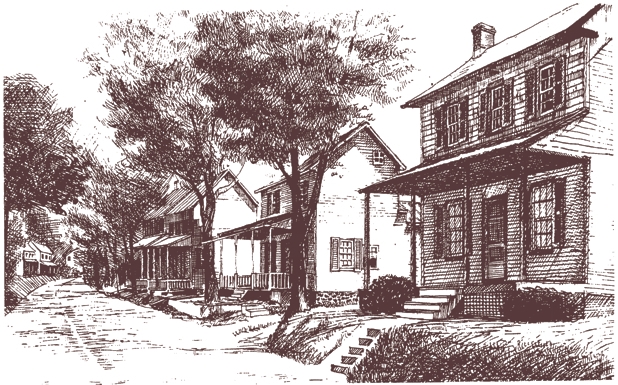
In 1798, Jesse Hyatt laid out the town that bears his name from a small part of his extensive farm lands along the Great Road. He offered for sale 105 quarter acre lots in a double row down each side of the highway. Henry Poole, the first to buy, built the town’s earliest house in 1800 and became its first storekeeper. Jesse Hyatt’s brothers, Eli and Asa, also built houses in the town; Asa and his son-in-law Warner Welsh were leading merchants.
Growth was slow, however. By 1804, only six lots with buildings on them were listed on tax rolls; six more had been added by 1811. Nevertheless, the town was incorporated by the state in 1809, and it flourished in a small way. In addition to a store, it had a blacksmith, a carpenter, a tailor, and an inn to serve the needs of surrounding farmers and of travelers and wagoneers passing down the Great Road. A grist mill on Little Bennett Creek nearby was operating even before the town itself had been established. Quarries in the area shipped roofing slate for the Capitol and other buildings in Washington. The Hyattstown Volunteers were formed in response to the War of 1812. By 1815, the town had its own constable and had become one of Montgomery County’s “hundreds” – forerunners of today’s election districts.
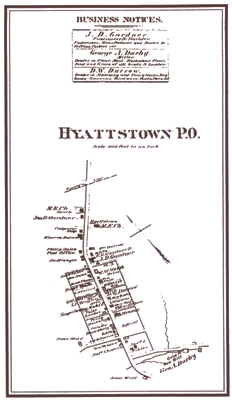 The Great Road, Hyattstown’s link to the outside world and its window on history, carried notables to and from Washington and provided a route for hauling grain or driving farm herds to market. But the road was “great” in name only. Deeply rutted and dusty in dry weather, it became a muddy morass after a heavy rain. Often it was nearly impassable, and its dismal condition was disparaged and deplored by the local press and public. Not until 1925 was it paved. The Great Road, Hyattstown’s link to the outside world and its window on history, carried notables to and from Washington and provided a route for hauling grain or driving farm herds to market. But the road was “great” in name only. Deeply rutted and dusty in dry weather, it became a muddy morass after a heavy rain. Often it was nearly impassable, and its dismal condition was disparaged and deplored by the local press and public. Not until 1925 was it paved.
Much of the Great Road’s freight traffic was siphoned off by the new Baltimore and Ohio Railroad which began operations in 1831, endowing such rival towns as Monrovia with brief prosperity. But Hyattstown did not suffer greatly, for Washington and Georgetown continued to be magnets that attracted constant streams of travelers through the village.
The contending armies of the Civil War knew the area well. J.E.B. Stuart’s Confederate cavalry occupied Hyattstown, skirmishing with Union forces there in September 1861, prior to Antietam. Stuart passed through again the following month pursued by Union troops, while returning from a raid in Pennsylvania. In 1863, the Union Sixth Corps halted briefly at Hyattstown on its way to Gettysburg. And in July of the next year Jubal Early’s forces, fresh from victory at the Monocacy, swept through on their way to attack Washington.
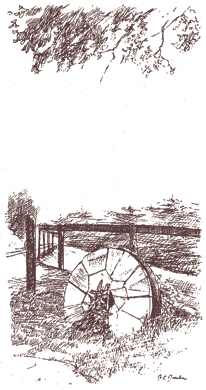 Throughout the 19th century, Hyattstown catered to travelers and nearby farm population with a modest parade of lodgings and local services. By the 1870’s it had a population of about 150, among them a postmaster, two blacksmiths, three carpenters and undertakers (the two occupations often were combined since one of the chief tasks of an undertaker was to fashion wooden coffins), a physician, a miller, a shoemaker, a tailor, and makers of carriages and buggies and of saddles and harness. Mountain View Park, just to the north, was a popular spot for jousting tournaments, picnics, band concerts, speeches, ball games, and like diversions for the hard-working townspeople. The park, now owned by the Hyattstown Volunteer Fire Department, has fallen into disuse. Throughout the 19th century, Hyattstown catered to travelers and nearby farm population with a modest parade of lodgings and local services. By the 1870’s it had a population of about 150, among them a postmaster, two blacksmiths, three carpenters and undertakers (the two occupations often were combined since one of the chief tasks of an undertaker was to fashion wooden coffins), a physician, a miller, a shoemaker, a tailor, and makers of carriages and buggies and of saddles and harness. Mountain View Park, just to the north, was a popular spot for jousting tournaments, picnics, band concerts, speeches, ball games, and like diversions for the hard-working townspeople. The park, now owned by the Hyattstown Volunteer Fire Department, has fallen into disuse.
The last “army” to pass through the town was Coxey’s Army, a motley group of out-of-work men being led by Populist Jacob Coxey to Washington to petition for economic reform. On April 26, 1894, local citizens provided meals and lodging for some of these ragtag visitors, while the rest camped along Little Bennett Creek, and later turned out for an evening of speeches and festivities.
The through traffic that once swarmed along the Old Great Road has been siphoned off since the 1958 completion of parallel Interstate 270, half a mile to the west. Today, even with the divided highway nearby, heavy rush hour commuter traffic flows through Hyattstown from the rapidly developing Green Valley and Urbana areas to the north.
Hyattstown today shows renewed vigor. In 1986, Hyattstown was designated a historic district by Montgomery County elected officials, honoring the fact that it has as one of the largest groupings of relatively unaltered 19th century buildings in Montgomery County. In the early 2000s, the County built an improved wastewater treatment plant for the area, thus protecting Little Bennett Creek and simultaneously encouraging owners of many older houses to restore them and allowing new houses to be constructed on vacant parcels. Little Bennett Regional Park, east of town is another stimulus. Although the Hyatts have been gone for more than a century, many descendants, including Wolfes, Welshes, and Zieglers, still live in the area. The town’s economy, with its filling station, auto dealership, store, and eating places, is still geared to the needs of highway users as well as the nearby farm community, while churches and the fire department remain centers for community social events.
A Walk Around Hyattstown
First, a word of caution: Be very careful when walking through Hyattstown. Traffic is heavy, especially during the workweek but also on weekends and holidays; drivers often travel above the speed limit. Sidewalks can be uneven, or may not exist at all. Wear bright colors when walking or biking so drivers can see you. Children and pets need protection, and the town is not a good cycling area. Please walk or park bikes in Hyattstown.
Cars and bikes can be parked at the lower end of town in the lot near the fire station, where Hyattstown Mill Road joins Rt. 355. As you walk in Hyattstown, please respect the privacy of residents. Bikers can top off the walking tour with a pleasant cycling excursion through Little Bennett Regional Park and the nearby countryside.
1. Volunteer Fire Department and Site of Tabler’s Tannery
Organized May 2, 1929, (as its uniform emblem proudly states) the Hyattstown Volunteer Fire Department occupied the concrete block structure before moving south to its present brick headquarters, built in 1942.
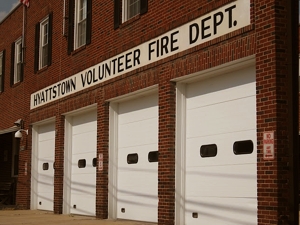
Volunteer Fire Department
On this site was one of Hyattstown’s two major enterprises, a tannery founded by Louis Tabler about 1825. Tanning, like milling, was based on local natural resources – in this case, oak bark from nearby forests and hides from upland herds. Continued by his two sons, William and Abraham, it operated until shortly after Abraham’s death in 1868. The tannery consisted of 18 vats, a bark shed, flesher sheds, an engine house and other buildings. Water for the operation came from a dam located about a mile up Little Bennett Creek, and was carried to the tannery by a canal.
Immediately across the road, where a small brick house stands, was the Tabler-Price Hotel, built about 1800 but torn down many years ago. It is said that in 1829, when Andrew Jackson was en route to his inauguration, he stopped in Hyattstown for the night. The Hyatt House was recommended, but Jackson insisted on staying where “the wagoners all stop,” the Tabler Hotel.
North of the present restaurant (on your right) just above the site of the former Dutrow-Darby general store, stood the local creamery. Here about 1900, cream was separated from the whole milk and then transported to the railroad for shipment to Baltimore.
We suggest you now walk north from the traffic light, using the left side as you walk uphill facing oncoming traffic, at least until reaching the Methodist Church at the far end of town. Hyattstown sidewalks are sparse and in poor condition, so please use caution. Sites 2 through 5 will be on the opposite side of the street.
2. Five Victorian Houses
The first five houses across the street are characteristic of the town’s fine late 19th century buildings. Two of them began as log structures equipped with large stone fireplaces. Here lived the town merchants, the Dutrows and the Welshes. Look for the brick stove chimneys, tin roofs, half-round gable windows and the traces of carpenter’s art in the gingerbread brackets and detailing of porches, latticework, fish-scale shingles and German siding. In an earlier time, these houses had downspouts that carried rainwater to the street, a feature of small town architecture in many parts of western Maryland.
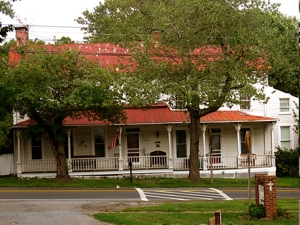
Jesse Hyatt Hotel
3. Hyatt House Hotel
The next building, also across the street (it has a red roof and is directly across the highway from the Hyattstown Christian Church), is a rambling, weather-beaten old house, part log, built in several sections during the early and mid-1800s. It was one of the 12 houses in Hyattstown in 1811. It served for a while as a hotel run by Asa Hyatt. James K. Polk stayed here in 1845 on his way to his Presidential inauguration. The building later was used as part of Warner and later Wellington Welsh’s general store. Among several old outbuildings on the property is a summer kitchen.
4. E.G. Gardner House
The next house was built sometime before the Civil War, perhaps as early as 1810. The two oldest sections of the house are of log construction, now covered with frame siding. Its most prominent resident was E. Grafton Gardner, a local builder and contractor. He acquired the house in 1862 and remodeled its interior, plastering over the original log walls and installing wood window frames. There was a blacksmith’s shop here also.
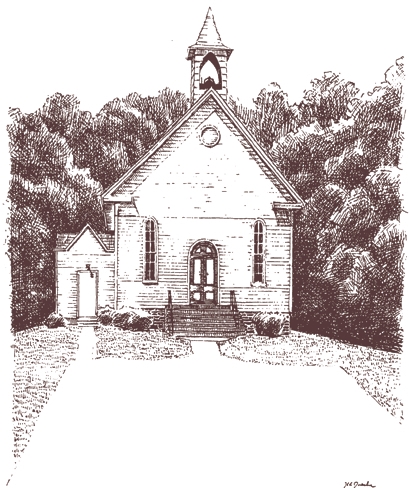 5. Methodist Episcopal Church, North 5. Methodist Episcopal Church, North
The congregation of the church on the East side of the Road, at the northern edge of town, was organized in 1804 when 18 members built a log church on this site, purchased from Eli Hyatt. In 1852, the log church was destroyed by fire; four years later the present masonry and stucco building was built by John Gardner. The congregation split in 1865 (this happened 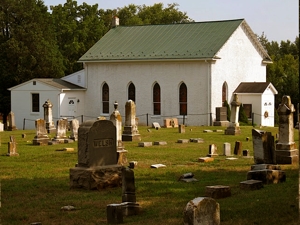 in Methodist Episcopal churches throughout the country, not just in Hyattstown; the issue was whether congregations were for or against abolition of slavery, with northern churches for, the southern churches against.) In Hyattstown, a second church, Methodist Episcopal South, put up its own building across the road (see Site 6). Later, the two churches reunited and continue to use this building and its adjacent cemetery. Take a few moments to cross the highway so you can stroll through this small serene cemetery—you’ll find monuments to many of the families mentioned earlier in our story of Hyattstown history. in Methodist Episcopal churches throughout the country, not just in Hyattstown; the issue was whether congregations were for or against abolition of slavery, with northern churches for, the southern churches against.) In Hyattstown, a second church, Methodist Episcopal South, put up its own building across the road (see Site 6). Later, the two churches reunited and continue to use this building and its adjacent cemetery. Take a few moments to cross the highway so you can stroll through this small serene cemetery—you’ll find monuments to many of the families mentioned earlier in our story of Hyattstown history.
6. Methodist Episcopal Church, South
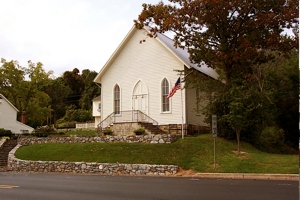 Again, on the west side of the Road continue up the Road a little way to the white frame country Gothic Revival building on the west side of Rt. 355. This church was erected in 1875 by a congregation that had split from the earlier Methodist Church in 1865 (Site 5) as a result of differences stemming from the Civil War. Once the two congregations reunited in 1939, the building eventually switched to commercial use (e.g., a gun shop, or later, a swimming pool retail outlet). The building is now in private ownership and in 2002 became known as The Chapel at Milton Ridge. The new owner completed extensive renovations to make the chapel historically accurate and structurally sound. It is now used as a venue for weddings and other events, and is rented to a small Anglican congregation for weekly religious services. Again, on the west side of the Road continue up the Road a little way to the white frame country Gothic Revival building on the west side of Rt. 355. This church was erected in 1875 by a congregation that had split from the earlier Methodist Church in 1865 (Site 5) as a result of differences stemming from the Civil War. Once the two congregations reunited in 1939, the building eventually switched to commercial use (e.g., a gun shop, or later, a swimming pool retail outlet). The building is now in private ownership and in 2002 became known as The Chapel at Milton Ridge. The new owner completed extensive renovations to make the chapel historically accurate and structurally sound. It is now used as a venue for weddings and other events, and is rented to a small Anglican congregation for weekly religious services.
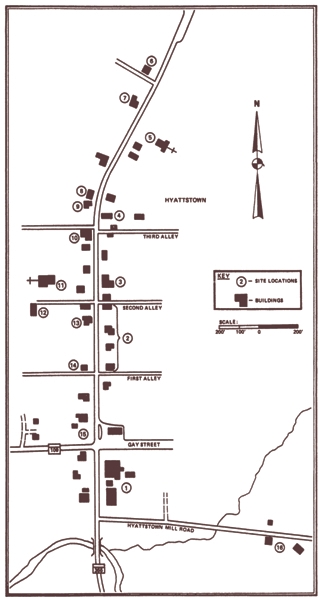 7. John Gardner House 7. John Gardner House
As you walk back downhill (west side of the road) re-tracing your steps, you’ll be looking at buildings on the same side as your walk. Just to the south of the former church is a house built partly of logs sometime before the Civil War that is one of Hyattstown’s earliest. John Gardner and his family were carpenters and undertakers during the 19th century.
8. Smith-Darby House
Continue down the western edge of Route 355 to where it curves. Philemon M. Smith, Sr., who was postmaster and magistrate for Hyattstown, built this large brick Federal-style house on the curve about 1840. The small frame shed standing at the rear of the house probably served as his post office. The brick wing on the south end of the house was used as an office for three different physicians who lived here later. It has been lived in for many years by the Darby family.
9. Brengle House
The front part of the next closely adjacent house was a log cabin built in the early 1800’s by two prominent local residents and mill owners, Dr. Belt Brashear and Eli Brashear. The original house was enlarged upward and to the rear several times until it acquired its present appearance. German siding and other trim were added during the Victorian period by John Brengle, a carriage and buggy maker and later a painter and decorator. Brengle bought the house in 1864 and lived there until 1896. Subsequently it was occupied by members of the Burdette family. Early records indicate that a blacksmith shop was one located on the property.
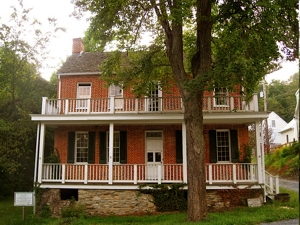
Davis House
10. Davis House
The next house, brick Federal in style, is perhaps the handsomest building in town – and also one of the oldest still standing. George Davis, a wealthy merchant who organized a militia unit during the War of 1812, purchased two lots from Jesse Hyatt in 1809 for 20 pounds, and built this house on one of them before selling it in 1815. It has Flemish bond brickwork in front, brick dentil cornices, and flush fireplace chimneys at each end. Its full-length porch at one time was topped with a balcony opening out from the second floor. Friends of Historic Hyattstown, Inc. is working to save the house. Private owners have stabilized the structure.
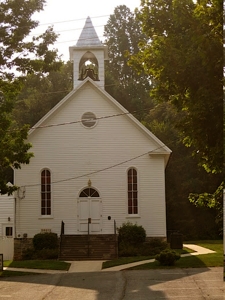 11. Christian Church and Parsonage 11. Christian Church and Parsonage
Focus attention now on the Hyattstown Christian Church, organized in 1840. Its first church building, a log meeting house, was on a corner of the church cemetery, which is along Route 355 just south of town. (Jesse Hyatt is buried there.) The present two-story frame church building, imposingly set back from the road and framed by adjacent buildings, was built at a cost of $3000 in 1871, at which time the congregation had about 40 members. The frame parsonage closer to the highway was built during the 1920’s.
12. Hyattstown School
From the church parking lot, you can see this one-room schoolhouse, up one of the alleys originally planned by Jesse Hyatt. Now a private residence, this frame one-room schoolhouse was built about 1880. It started with two teachers and through most of the period during which it was used it housed grades one through seven. Abandoned as a school, it was auctioned in 1947.
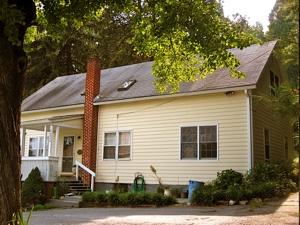 An earlier one-room frame school had been built in Hyattstown during the 1830’s on a small plot about 250 feet back from the east side of Route 355. Because it was located on a low and rather marshy piece of ground, it was familiarly known as “Swamp College.” The school was attended by 60 to 70 pupils who were taught through the first eight grades. One of its last teachers, Miss Mary Miller, became famous for organizing evening entertainments, held in the schoolroom by the light of coal oil lamps, that attracted people from as far away as Frederick. After half a century of service, Swamp College finally was abandoned. Nothing of it remains. An earlier one-room frame school had been built in Hyattstown during the 1830’s on a small plot about 250 feet back from the east side of Route 355. Because it was located on a low and rather marshy piece of ground, it was familiarly known as “Swamp College.” The school was attended by 60 to 70 pupils who were taught through the first eight grades. One of its last teachers, Miss Mary Miller, became famous for organizing evening entertainments, held in the schoolroom by the light of coal oil lamps, that attracted people from as far away as Frederick. After half a century of service, Swamp College finally was abandoned. Nothing of it remains.
13. Zeigler House
Continuing downhill, look at the second house after leaving the church parking lot. David Zeigler built this house c. 1850 and sold it to his son, Levi, in 1866. Levi Zeigler demonstrated and sold sewing machines from this building in the 1870’s and 1880’s for the Singer Sewing Machine Company. Besides running the office, Zeigler probably took various models on a wagon to outlying farms. The Singer Company was the first to offer “installment buying” to its customers.
14. Tailor Shop
William Davis operated a tailor’s shop here in the next small two-story frame building (now sheathed with aluminum siding) in the 1860’s and 1870’s. He rented quarters from the Leather family. An old carriage shed can be seen on the hill behind the house.
15. Dutrow’s Blacksmith Shop
A vestige of Hyattstown’s association with the Great Road is the site of Dutrow’s blacksmith shop, at the intersection of Routes 109 and 355. It flourished in the period of 1870-1900, and it was replaced by the present building shortly after 1915. This was one of Hyattstown’s two blacksmith shops.
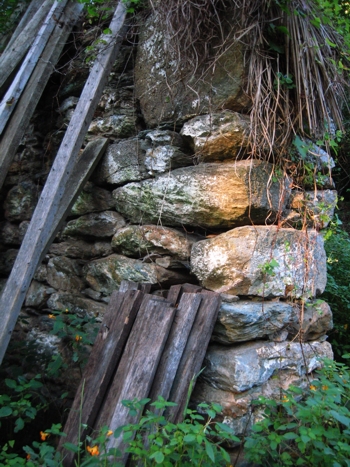
Hyattstown Mill Rock Wall
16. Hyattstown Mill and Miller’s House
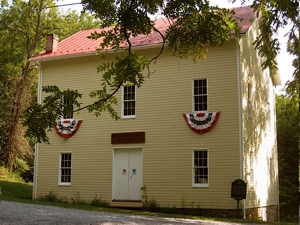 Before returning to your car, walk two-tenths of a mile up Hyattstown Mill Road to see the Hyattstown Mill and Miller’s House, the last site on the walking tour. Or, if you plan to do the lovely cycling excursion (described below), you can see the mill on your return. Before returning to your car, walk two-tenths of a mile up Hyattstown Mill Road to see the Hyattstown Mill and Miller’s House, the last site on the walking tour. Or, if you plan to do the lovely cycling excursion (described below), you can see the mill on your return.
A mill was operating at this location along Hyattstown Mill Road before the town itself was originally laid out in 1798. It ground corn meal and wheat flour for local farmers from their own grains. The present building, enclosed in corrugated steel, replaced an earlier structure that burned down in 1918. Although this building is in a good state of repair, it has lost its machinery. It is now used as an art center, the Hyattstown Mill Arts Project, where local artists and writers gather, hold shows, movies and performances. The gallery is usually open on weekend afternoons. The millrace is intact, and the adjacent miller’s house still stands with its clapboard exterior. All of these buildings are now owned by the Maryland-National Capital Park and Planning Commission and are part of Little Bennett Regional Park.
Bicycling Excursion Through Little Bennett Regional Park
Walk your bike cautiously up Rt. 355 to Hyattstown’s northern edge. Turn right at Rt. 75 and begin a ride through undulating countryside that is becoming a patchwork of pastures, fields, and new subdivisions. After the road crosses Little Bennett Creek turn right on Price’s Distillery Road, a narrow road named for the distillery complex that once stood near the intersection. Be careful: These are all narrow roads.
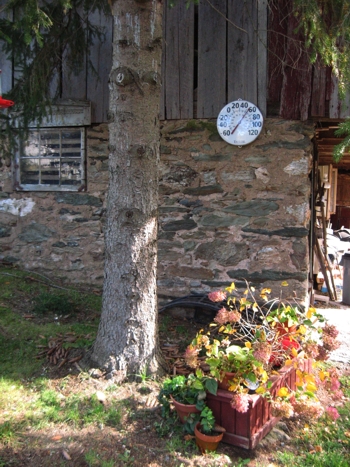
Price Distillery Barn
17. Price’s Distillery Buildings
Here were located a mill – which dated back to at least 1800 – and a distillery operated by Levi Price in the late 19th and early 20th century. Both were burned in the 1930’s, allegedly by angry Hyattstown prohibitionists who pushed a burning hay wagon down Price’s Distillery Road and into the distillery. Only the foundations of the distillery, and some supporting pillars and a millstone from the mill are now visible. The distiller’s house remains. Levi Price lived in the large frame house on the hill overlooking the road and the distillery site. The center section probably was built about 1760, but has been greatly altered since then. Across the road from this main house is the Price’s Distillery Office, now called Thistle Hill Cottage, a tiny but charming Gothic Revival style house built in the 1860’s. Originally a dwelling, the cottage was converted to se as an office and guest house for the Price Distillery some time after 1870. Customers visiting to buy sour mash whiskey could be entertained here or put up overnight. The cottage was restored in 1975. The barn closely adjacent to the cottage served as a stable for the teams of horses that hauled barrels of whiskey to the railroad station at Monrovia, a few miles to the north.
From Price’s Distillery continue on Price’s Distillery Road past heavy woods, farmland, and the Pheasant Lane development down to a bridge at Bennett Creek. At the first intersection after the creek, turn right and take Haines Road. Turn left to Lewisdale Road, and then immediately right onto Prescott Road.
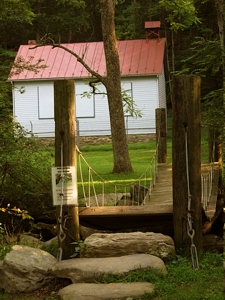
Kingsley School
18. Little Bennett Regional Park
Prescott Road parallels Little Bennett Golf Course, an 18-hole public golf course with stunning views of the rolling countryside and Sugarloaf Mountain. You are welcome to stop for refreshments in the clubhouse. Not long after passing the golf course, Prescott Road’s pavement stops but you can continue biking on the trail as it takes you into Little Bennett Regional Park. With more than 3000 acres, Little Bennett is the largest county-owned park in Montgomery County. This huge, beautiful park offers overnight camping (entrance to the campsite area is off Rt. 355), picnic areas, many historic structures and miles of hiking and bridle trails.
At the intersection of Prescott Road and Hyattstown Mill Road (both are unpaved park trails) are the remains of a 19th century bone mill (where fertilizer was made), marked by a stone wall 100 feet to the south. Turn right onto Hyattstown Mill Road and ride back to town following the old mill-race of the Hyattstown Mill.
To see the old hand drawn Trail Guide site maps for the Hyattstown Walking Trail (now out of date), please go here.
D. Kiefer 1980
M. Dwyer, H. Larsen 1997
Meg Menke 2010 |

